微生物(期末考题答案(西南科技大学)
- 格式:doc
- 大小:70.00 KB
- 文档页数:8
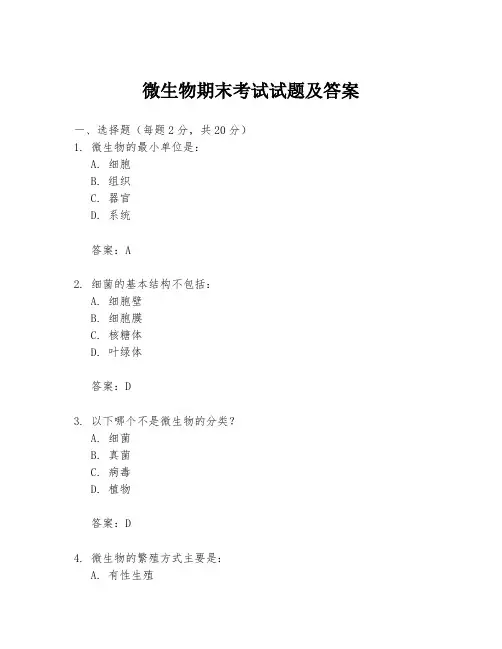
微生物期末考试试题及答案一、选择题(每题2分,共20分)1. 微生物的最小单位是:A. 细胞B. 组织C. 器官D. 系统答案:A2. 细菌的基本结构不包括:A. 细胞壁B. 细胞膜C. 核糖体D. 叶绿体答案:D3. 以下哪个不是微生物的分类?A. 细菌B. 真菌C. 病毒D. 植物答案:D4. 微生物的繁殖方式主要是:A. 有性生殖B. 无性繁殖C. 孢子生殖D. 卵生答案:B5. 微生物的培养基通常不包括以下哪种成分?A. 水B. 碳源C. 氮源D. 氧气答案:D二、填空题(每空1分,共10分)1. 微生物的分类依据主要包括形态结构、生理生化特性和__________。
答案:遗传特性2. 微生物的细胞结构中,__________是细胞内遗传物质的载体。
答案:核糖体3. 微生物的代谢类型包括异养、自养、好氧和__________。
答案:厌氧4. 病毒的组成主要包括核酸和__________。
答案:蛋白质外壳5. 微生物的培养方法主要有平板培养法、__________和液体培养法。
答案:固体培养法三、简答题(每题10分,共30分)1. 简述微生物在食品工业中的应用。
答案:微生物在食品工业中的应用非常广泛,包括发酵乳制品、酿造酒精饮料、生产酱油和醋等。
它们通过代谢过程产生特定的酶和有机酸,从而改变食品的风味和质地。
2. 什么是微生物的抗生素抗性,它是如何产生的?答案:微生物的抗生素抗性是指某些微生物能够抵抗抗生素的杀菌作用。
这种抗性通常是由于基因突变或通过水平基因转移获得抗性基因,使得微生物能够代谢或排除抗生素,或者改变抗生素的作用靶点。
3. 微生物在环境保护中的作用是什么?答案:微生物在环境保护中扮演着重要角色,包括分解有机废物、净化污水、生物修复土壤等。
它们通过自身的代谢活动,将有害物质转化为无害或低毒的物质,从而减轻环境污染。
四、论述题(每题15分,共30分)1. 论述微生物在医学领域的应用及其重要性。
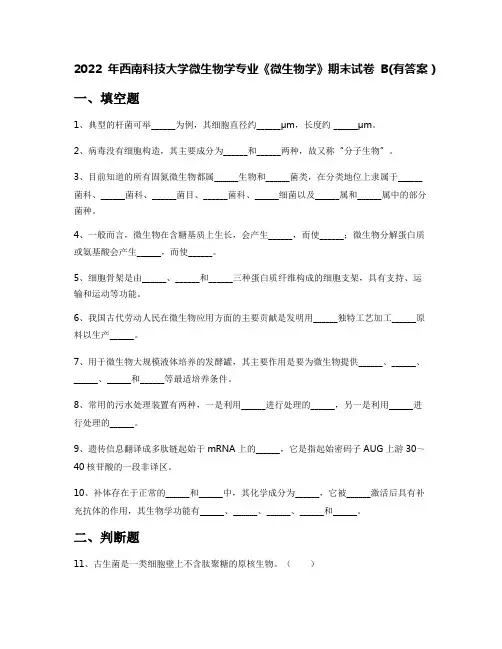
2022年西南科技大学微生物学专业《微生物学》期末试卷B(有答案)一、填空题1、典型的杆菌可举______为例,其细胞直径约______μm,长度约______μm。
2、病毒没有细胞构造,其主要成分为______和______两种,故又称“分子生物”。
3、目前知道的所有固氮微生物都属______生物和______菌类,在分类地位上隶属于______菌科、______菌科、______菌目、______菌科、______细菌以及______属和______属中的部分菌种。
4、一般而言,微生物在含糖基质上生长,会产生______,而使______;微生物分解蛋白质或氨基酸会产生______,而使______。
5、细胞骨架是由______、______和______三种蛋白质纤维构成的细胞支架,具有支持、运输和运动等功能。
6、我国古代劳动人民在微生物应用方面的主要贡献是发明用______独特工艺加工______原料以生产______。
7、用于微生物大规模液体培养的发酵罐,其主要作用是要为微生物提供______、______、______、______和______等最适培养条件。
8、常用的污水处理装置有两种,一是利用______进行处理的______,另一是利用______进行处理的______。
9、遗传信息翻译成多肽链起始于mRNA上的______,它是指起始密码子AUG上游30~40核苷酸的一段非译区。
10、补体存在于正常的______和______中,其化学成分为______,它被______激活后具有补充抗体的作用,其生物学功能有______、______、______、______和______。
二、判断题11、古生菌是一类细胞壁上不含肽聚糖的原核生物。
()12、氨基酸在碳源缺乏时可被微生物用作碳源物质,但不能提供能源。
()13、原核生物呼吸链的P/O比一般较真核生物高。
()14、噬菌体侵染宿主细胞时,蛋白质和核酸同时进入宿主细胞。
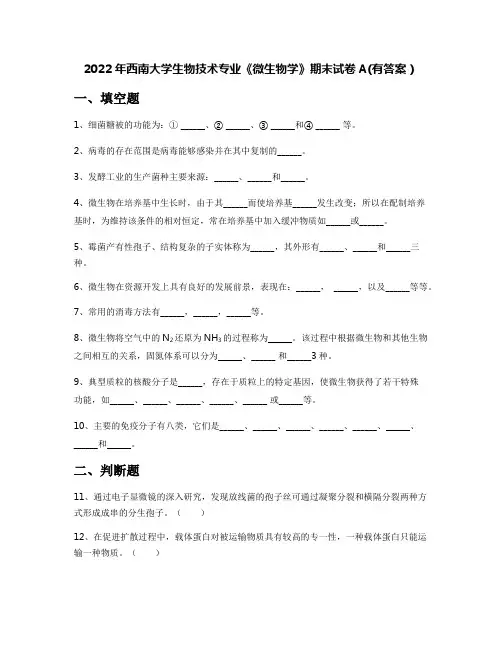
2022年西南大学生物技术专业《微生物学》期末试卷A(有答案)一、填空题1、细菌糖被的功能为:① ______、② ______、③ ______和④ ______ 等。
2、病毒的存在范围是病毒能够感染并在其中复制的______。
3、发酵工业的生产菌种主要来源:______、______和______。
4、微生物在培养基中生长时,由于其______而使培养基______发生改变;所以在配制培养基时,为维持该条件的相对恒定,常在培养基中加入缓冲物质如______或______。
5、霉菌产有性孢子、结构复杂的子实体称为______,其外形有______、______和______三种。
6、微生物在资源开发上具有良好的发展前景,表现在:______,______,以及______等等。
7、常用的消毒方法有______,______,______等。
8、微生物将空气中的N2还原为NH3的过程称为______。
该过程中根据微生物和其他生物之间相互的关系,固氮体系可以分为______、______ 和______3种。
9、典型质粒的核酸分子是______,存在于质粒上的特定基因,使微生物获得了若干特殊功能,如______、______、______、______、______ 或______等。
10、主要的免疫分子有八类,它们是______、______、______、______、______、______、______和______。
二、判断题11、通过电子显微镜的深入研究,发现放线菌的孢子丝可通过凝聚分裂和横隔分裂两种方式形成成串的分生孢子。
()12、在促进扩散过程中,载体蛋白对被运输物质具有较高的专一性,一种载体蛋白只能运输一种物质。
()13、硫细菌、铁细菌和硝化细菌等化能自养菌不能通过Calvin循环进行CO2的固定。
()14、噬菌体核酸既有单链DNA、双链DNA,又有单链RNA、双链RNA。
()15、酵母菌是一类只发酵糖类且细胞都呈单细胞的真菌。
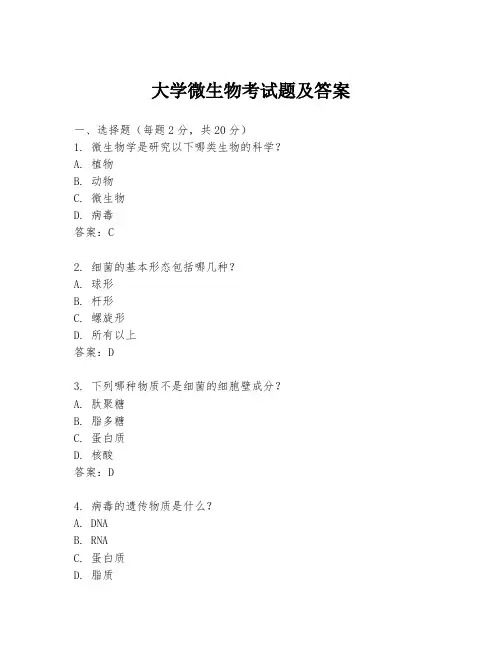
大学微生物考试题及答案一、选择题(每题2分,共20分)1. 微生物学是研究以下哪类生物的科学?A. 植物B. 动物C. 微生物D. 病毒答案:C2. 细菌的基本形态包括哪几种?A. 球形B. 杆形C. 螺旋形D. 所有以上答案:D3. 下列哪种物质不是细菌的细胞壁成分?A. 肽聚糖B. 脂多糖C. 蛋白质D. 核酸答案:D4. 病毒的遗传物质是什么?A. DNAB. RNAC. 蛋白质D. 脂质答案:A或B5. 哪种微生物属于原核生物?A. 酵母B. 霉菌C. 细菌D. 原生动物答案:C6. 芽孢是某些细菌的什么结构?A. 营养储存结构B. 繁殖结构C. 保护结构D. 运动结构答案:C7. 微生物的培养基通常包含哪些成分?A. 碳源B. 氮源C. 无机盐D. 所有以上答案:D8. 哪种微生物是人体肠道中常见的有益菌?A. 大肠杆菌B. 乳酸菌C. 金黄色葡萄球菌D. 沙门氏菌答案:B9. 抗生素的主要作用是什么?A. 促进细胞生长B. 抑制微生物生长C. 增强免疫力D. 治疗病毒感染答案:B10. 微生物的分类依据主要包括哪些方面?A. 形态特征B. 生理生化特性C. 遗传信息D. 所有以上答案:D二、填空题(每空1分,共20分)1. 微生物包括_______、细菌、真菌、病毒等。
答案:古菌2. 微生物的细胞结构可以分为_______和真核细胞。
答案:原核细胞3. 微生物的新陈代谢可以分为_______和异养。
答案:自养4. 微生物的繁殖方式主要有分裂、出芽和_______。
答案:孢子形成5. 微生物的分类单位从大到小依次是界、门、纲、目、科、_______、种。
答案:属三、简答题(每题10分,共30分)1. 简述微生物在生态系统中的作用。
答案:微生物在生态系统中扮演着分解者、生产者和消费者的角色,参与物质循环和能量流动,对维持生态平衡具有重要作用。
2. 描述一下微生物实验室常用的无菌操作技术。
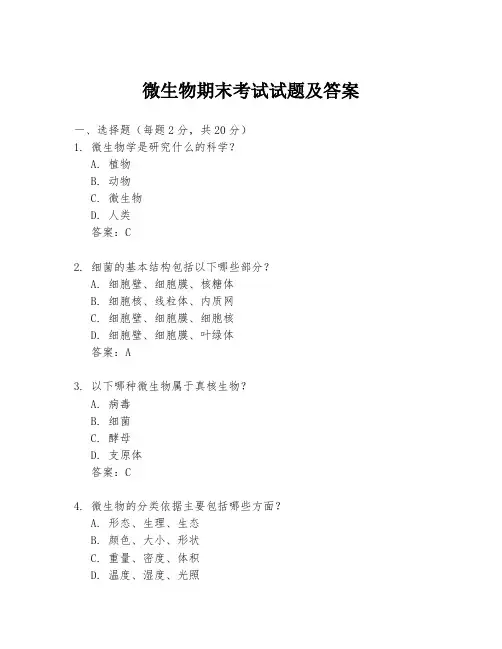
微生物期末考试试题及答案一、选择题(每题2分,共20分)1. 微生物学是研究什么的科学?A. 植物B. 动物C. 微生物D. 人类答案:C2. 细菌的基本结构包括以下哪些部分?A. 细胞壁、细胞膜、核糖体B. 细胞核、线粒体、内质网C. 细胞壁、细胞膜、细胞核D. 细胞壁、细胞膜、叶绿体答案:A3. 以下哪种微生物属于真核生物?A. 病毒B. 细菌C. 酵母D. 支原体答案:C4. 微生物的分类依据主要包括哪些方面?A. 形态、生理、生态B. 颜色、大小、形状C. 重量、密度、体积D. 温度、湿度、光照答案:A5. 以下哪种微生物是引起食物腐败的主要原因?A. 细菌B. 病毒C. 真菌D. 原生动物答案:A6. 微生物的代谢类型包括哪些?A. 厌氧型和好氧型B. 光合型和异养型C. 异养型和自养型D. 所有以上选项答案:D7. 以下哪种微生物是单细胞生物?A. 病毒B. 细菌C. 真菌D. 原生动物答案:B8. 微生物的繁殖方式有哪些?A. 有丝分裂B. 无性生殖C. 孢子生殖D. 所有以上选项答案:B9. 微生物在生态系统中扮演什么角色?A. 消费者B. 生产者C. 分解者D. 寄生者答案:C10. 微生物的培养基通常由哪些成分组成?A. 营养物质、水分、pH调节剂B. 氧气、二氧化碳、氮气C. 矿物质、维生素、氨基酸D. 所有以上选项答案:A二、填空题(每空1分,共10分)11. 微生物的分类单位从大到小依次是_______、_______、_______、_______、_______。
答案:界、门、纲、目、种12. 微生物的生长曲线通常分为四个阶段,分别是_______、_______、_______和_______。
答案:滞后期、对数期、稳定期、衰亡期13. 微生物的遗传物质主要是_______。
答案:DNA14. 微生物在医学上的应用包括_______、_______和_______。

2021年西南科技大学微生物学专业《微生物学》期末试卷B(有答案)一、填空题1、常见的球菌类细菌的代表属有______,______,______等。
2、植物病毒一般可引起宿主植物三类明显的症状:① ______;② ______;③ ______。
3、1分子葡萄糖底物经EMP途径产生______分子丙酮酸,______分子NADH+H+和______分子ATP。
4、在微生物研究和生长实践中,选用和设计培养基的最基本要求是______、______、______、______、______和______。
5、曲霉分生孢子头的构造为:分生孢子梗的基部有一特征性的______,向上则分化出______、______、______和______,这四种总称为______。
6、要加速发展我国的微生物学,应努力从以下几个方面人手: ______;______;______;______等。
7、影响微生物生长的主要因素有______、______、______、______和______等。
8、常用的污水处理装置有两种,一是利用______进行处理的______,另一是利用______进行处理的______。
9、采用紫外线杀菌时,以波长为______的紫外线照射最好。
10、细菌性病原体会通过产生______、______和______等物质危害宿主;病毒会通过______、______和______等方式危害宿主;而真菌则会通过______、______、______和______等方式危害其宿主。
二、判断题11、放线菌是一类陆生性较强的原核生物,它们产生的孢子都是不长鞭毛的。
()12、实验室做固体培养基时,常加1.8%的琼脂作凝固剂,做半固体培养基时,琼脂加入量通常是0.5%。
()13、硫细菌、铁细菌和硝化细菌等化能自养菌不能通过Calvin循环进行CO2的固定。
()14、拟病毒是一类存在于辅助病毒颗粒中的卫星RNA,故必须依赖辅助病毒才能侵染植物和得到复制。
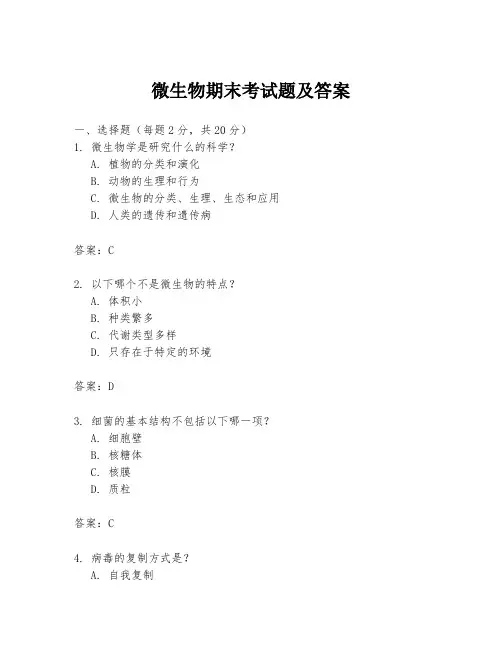
微生物期末考试题及答案一、选择题(每题2分,共20分)1. 微生物学是研究什么的科学?A. 植物的分类和演化B. 动物的生理和行为C. 微生物的分类、生理、生态和应用D. 人类的遗传和遗传病答案:C2. 以下哪个不是微生物的特点?A. 体积小B. 种类繁多C. 代谢类型多样D. 只存在于特定的环境答案:D3. 细菌的基本结构不包括以下哪一项?A. 细胞壁B. 核糖体C. 核膜D. 质粒答案:C4. 病毒的复制方式是?A. 自我复制B. 无性繁殖C. 有性繁殖D. 寄生复制答案:D5. 以下哪个是真核微生物?A. 细菌B. 放线菌C. 酵母菌D. 支原体答案:C...(此处省略其他选择题)二、填空题(每空1分,共10分)1. 微生物的分类依据包括形态结构、生理生化特性、______、______等。
答案:遗传特性;生态习性2. 微生物的培养需要适宜的______、______、pH值、氧气供应等条件。
答案:温度;营养物质...(此处省略其他填空题)三、简答题(每题10分,共30分)1. 简述微生物在环境保护中的作用。
答案:微生物在环境保护中扮演着重要角色。
它们参与废水处理,通过分解有机污染物来净化水质;在土壤修复中,微生物能够分解土壤中的有害物质,恢复土壤肥力;在大气净化中,某些微生物能够吸收和转化有害气体,减少大气污染。
2. 描述细菌的基本结构。
答案:细菌的基本结构包括细胞壁、细胞膜、细胞质和核糖体。
细胞壁为细菌提供保护和支撑,细胞膜负责物质的进出,细胞质中包含各种细胞器和酶,核糖体是蛋白质合成的场所。
...(此处省略其他简答题)四、计算题(每题15分,共15分)1. 如果一个细菌的体积是 \(10^{-15}\) 升,计算1升培养液中大约含有多少个细菌(假设培养液中细菌均匀分布)。
答案:如果1升培养液中细菌均匀分布,那么1升培养液的体积是\(10^{3}\) 升。
每个细菌的体积是 \(10^{-15}\) 升,所以1升培养液中大约含有 \(10^{3} / 10^{-15} = 10^{18}\) 个细菌。
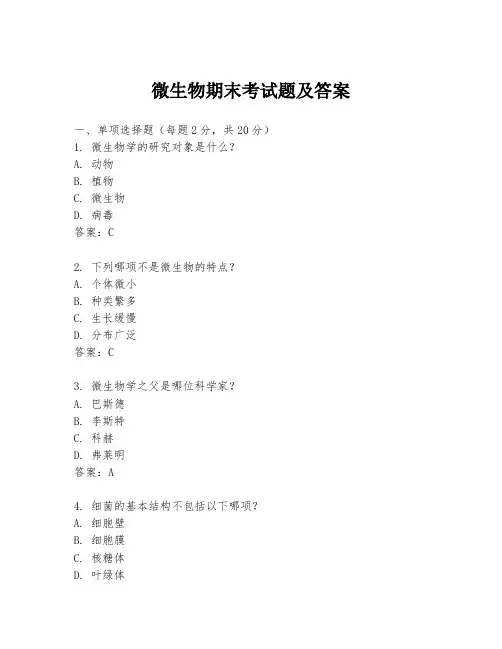
微生物期末考试题及答案一、单项选择题(每题2分,共20分)1. 微生物学的研究对象是什么?A. 动物B. 植物C. 微生物D. 病毒答案:C2. 下列哪项不是微生物的特点?A. 个体微小B. 种类繁多C. 生长缓慢D. 分布广泛答案:C3. 微生物学之父是哪位科学家?A. 巴斯德B. 李斯特C. 科赫D. 弗莱明答案:A4. 细菌的基本结构不包括以下哪项?A. 细胞壁B. 细胞膜C. 核糖体D. 叶绿体5. 真菌与细菌的主要区别是什么?A. 有无细胞核B. 有无细胞壁C. 有无鞭毛D. 有无孢子答案:A6. 病毒的结构特点是什么?A. 有细胞结构B. 无细胞结构C. 有叶绿体D. 有线粒体答案:B7. 哪种微生物是厌氧型?A. 乳酸菌B. 酵母菌C. 蓝细菌D. 绿藻答案:A8. 微生物在生态系统中的作用不包括以下哪项?A. 分解者B. 生产者C. 消费者D. 寄生者答案:C9. 微生物的繁殖方式不包括以下哪项?B. 孢子生殖C. 出芽生殖D. 有性繁殖答案:D10. 哪种微生物是人体肠道中的主要益生菌?A. 大肠杆菌B. 金黄色葡萄球菌C. 乳酸菌D. 沙门氏菌答案:C二、填空题(每题2分,共20分)1. 微生物是指那些需要借助_______才能观察到的微小生物。
答案:显微镜2. 微生物的分类依据包括形态结构、生理功能和_______。
答案:遗传特性3. 微生物的培养需要控制_______、_______和_______等条件。
答案:温度、pH、氧气4. 微生物的代谢类型包括好氧型、厌氧型和_______。
答案:兼性厌氧型5. 病毒没有_______结构,必须依赖宿主细胞才能繁殖。
答案:细胞6. 微生物的群体遗传变异主要通过_______、_______和_______实现。
答案:突变、基因重组、选择7. 微生物在食品工业中的作用包括_______、_______和_______。
答案:发酵、防腐、增香8. 微生物在环境保护中的作用包括_______、_______和_______。

2022年西南大学微生物学专业《微生物学》期末试卷B(有答案)一、填空题1、细菌细胞除基本结构外,还有诸如______、______、______和______等特殊结构。
2、植物病毒一般可引起宿主植物三类明显的症状:① ______;② ______;③ ______。
3、乙醛酸循环中的两个关键酶是______英文缩写是______和______英文缩写是______,它们可使______和______等化合物源源不断地合成______,以保证微生物正常合成的需要。
4、实验室配制固体培养基的操作程序是______、______、______、______、______、______、______。
5、真菌菌丝有两种类型,低等真菌的菌丝是______,高等真菌的菌丝是______。
6、被誉为微生物学奠基人的是______世纪、______国的______;而细菌学的奠基人则为______国的______。
7、最常见的厌氧菌有① ______,② ______,③ ______,④ ______,⑤ ______,⑥ ______等。
8、在菌种资源开发中,筛选菌种的四个步骤为:______、______、______和______。
9、用现代生物学技术对苏云金芽孢杆菌进行基因改造,使重组Bt菌株具有杀灭多种害虫的δ内毒素或β-外毒素基因,或具有某些______、______产生的基因,并高效表达,生产出受环境影响小、杀虫谱广、防昆虫抗性的强效Bt杀虫剂。
10、抗体是由______合成并分泌的免疫球蛋白。
二、判断题11、各种芽孢杆菌在其形成芽孢的同时,均会形成一个伴孢晶体。
()12、在配制微生物培养基时,所需要的大量元素一般只要提供K2HPO4 和MgSO4两种试剂即可。
()13、无氧呼吸是一类在无氧条件下进行的、产能效率较低的特殊呼吸。
()14、病毒粒不存在个体的生长过程,因此,同种病毒粒间并没有年龄和大小之别。
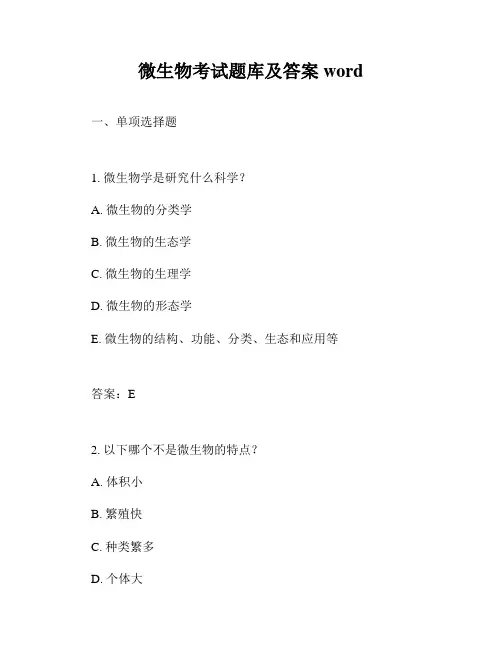
微生物考试题库及答案word一、单项选择题1. 微生物学是研究什么科学?A. 微生物的分类学B. 微生物的生态学C. 微生物的生理学D. 微生物的形态学E. 微生物的结构、功能、分类、生态和应用等答案:E2. 以下哪个不是微生物的特点?A. 体积小B. 繁殖快C. 种类繁多D. 个体大E. 分布广泛答案:D3. 微生物学的研究对象不包括以下哪一项?A. 细菌B. 真菌C. 病毒D. 原生动物E. 植物答案:E4. 以下哪种微生物是严格厌氧的?A. 大肠杆菌B. 乳酸菌C. 酵母菌D. 假单胞菌E. 绿脓杆菌答案:B5. 微生物的分类依据不包括以下哪一项?A. 形态特征B. 生理特征C. 遗传特征D. 环境因素E. 生化反应答案:D二、多项选择题6. 以下哪些是微生物的分类?A. 细菌B. 病毒C. 真菌D. 原生动物E. 藻类答案:ABCDE7. 微生物在生态系统中的作用包括哪些?A. 分解者B. 消费者C. 生产者D. 调节者E. 寄生者答案:ABCDE8. 微生物的培养方法包括哪些?A. 固体培养B. 液体培养C. 厌氧培养D. 好氧培养E. 混合培养答案:ABCDE9. 微生物的生理功能包括哪些?A. 代谢B. 繁殖C. 运动D. 感应E. 遗传答案:ABCDE10. 微生物的应用领域包括哪些?A. 食品工业B. 医药工业D. 环境保护E. 生物技术答案:ABCDE三、判断题11. 所有微生物都是单细胞生物。
(对/错)答案:错12. 病毒没有细胞结构。
(对/错)答案:对13. 微生物在自然界中只起到分解作用。
(对/错)答案:错14. 微生物可以进行光合作用。
(对/错)15. 微生物的遗传变异只能通过自然选择发生。
(对/错)答案:错四、填空题16. 微生物的____是研究微生物的基本方法。
答案:培养17. 微生物的____是微生物学研究的重要内容之一。
答案:分类18. 微生物的____是指微生物在一定条件下的生长繁殖能力。

2022年西南科技大学生物技术专业《微生物学》期末试卷A(有答案)一、填空题1、蓝细菌是光合微生物,进行______营养,单细胞蓝细菌以______繁殖为主,丝状体种类则以______繁殖。
蓝细菌没有鞭毛,但能进行______运动。
2、烟草花叶病毒简称______,外形______状,外层衣壳粒以______时,针方向螺旋状排列成______,具有______功能;核心为______链______。
3、以一种______作氢供体,而以另一种______作氢受体而实现生物氧化产能的独特发酵类型,称为Stickland反应。
此反应的产能效率很______,每分子______仅产______ATP。
4、在营养物质运输中既消耗能量又需要载体的运输方式是______和______。
5、酵母菌有性繁殖一般通过邻近的两个形态相同而性别不同的细胞各自伸出一根管状的原生质突起相互接触、局部融合并形成一条通道,再通过______、______和______形成四个或八个子核,然后它们各自与周围的原生质结合在一起,再在其表面形成一层孢子壁,这样一个个子囊孢子就成熟了,而原有的营养细胞则成了子囊。
6、现代微生物学发展有以下几个特点:______,______,______,______,______,______。
7、酸菜、饲料贮存是利用______发酵产生的______抑制______,使之得以长久贮存。
8、硝化作用需要在严格的______条件下进行,而反硝化作用则需要在______条件下进行。
9、通常情况下,菌种可保藏在______℃和______℃的低温下。
10、人体的白细胞种类很多,它们在免疫防御中具有重要作用,例如,具有吞噬功能的如______、______、______和______;无吞噬功能但在特异性免疫中作用极其重要的有两种,即______与______。
二、判断题11、链霉菌是霉菌,其有性繁殖形成接合孢子。
2021年西南科技大学微生物学专业《微生物学》期末试卷A(有答案)一、填空题1、G+细菌细胞壁上主要成分磷壁酸的生理功能为:① ______、② ______、③ ______和④ ______等。
2、病毒一步生长曲线有三个最重要的特征参数,即______期(包括______期和______期)和______期的长短以及______的大小。
3、TCA循环是指丙酮酸经过一系列的循环式反应而彻底氧化、脱羧、形成______、______和______的过程。
4、PA培养基通常用来培养______,其pH值为______。
5、曲霉分生孢子头的构造为:分生孢子梗的基部有一特征性的______,向上则分化出______、______、______和______,这四种总称为______。
6、第一个用自制显微镜观察到微生物的学者是______,被称为微生物学研究的先驱者,而法国学者______和德国学者______则是微生物生理学和病原菌学研究的开创者。
7、一条典型的生长曲线至少可分为______、______、______和______4个生长时期。
8、有机污染物生物降解过程中经历的主要反应包括______,______, ______和______。
9、微生物菌种保藏有两个原则,一是在菌种方面必须选用______;二是设法创造一个优良的休眠条件,例如______、______、______、______、______和______等。
10、补体主要有______细胞和______细胞产生,其化学成分为______,它被______激活后具补充抗体的作用。
二、判断题11、有荚膜的细菌,一般都可形成透明、黏湿、扁平的大形菌落。
()12、所有的培养基都是选择性培养基。
()13、EMP途径主要存在于厌氧生活的细菌中。
()14、细菌的溶源性是可以遗传的。
()15、白假丝酵母(Candida albicans)可产生无性的厚垣孢子。
2022年西南科技大学微生物学专业《微生物学》期末试卷A(有答案)一、填空题1、我国古代劳动人民在微生物应用方面的主要贡献是发明用______独特工艺加工______原料以生产______。
2、鞭毛是细菌的运动器官,观察细菌是否生鞭毛可通过______或______在光学显微镜下观察。
3、基因突变一般有七个共同特点:① ______,② ______,③ ______,④ ______,⑤______,⑥ ______和⑦ ______。
4、评价化学杀菌剂或治疗剂的药效和毒性的关系时,最重要的三个指标是______、______和______。
5、真菌菌丝有两种类型,低等真菌的菌丝是______,高等真菌的菌丝是______。
6、最大的病毒是直径为200nm的______;最小病毒之一是______,其直径仅为28nm。
7、沼气发酵的过程可分三个阶段,即______、______和______,其中第三阶段的主要菌种是______。
8、铵盐、硝酸盐和N2等。
@17、生长因子自养型微生物有______、______和______等种类。
9、在真核生物中,TCA循环的酶反应在______内进行,在原核生物中,则在______内进行,但______酶是一例外,它在真核生物的线粒体或原核生物细胞中都是结合在______上的。
10、在产抗体细胞的激活和抗体的形成过程中,需要有三种免疫活性细胞发挥作用:______,______,______。
二、判断题11、草食动物大部分都能分泌纤维素酶来消化所食用的纤维素。
()12、微生物营养就是微生物获得和利用营养物质的过程。
()13、在微生物细胞中,其诱导酶的种类要大大超过组成酶。
()14、在微生物的形态特征十分丰富的条件下,菌种鉴定就可完全依据这些特征来进行,例如真菌、放线菌和酵母菌等。
()15、因支原体的细胞大小接近病毒,故具有滤过性。
()16、酵母菌无性繁殖方式通常为裂殖,少数为芽殖。
2022年西南大学微生物学专业《微生物学》期末试卷A(有答案)一、填空题1、古生菌包括______、______和______等。
2、产甲烷古生菌在将______和______还原成甲烷的过程中,______是重要的产甲烷辅酶。
3、用现代生物学技术对苏云金芽孢杆菌进行基因改造,使重组Bt菌株具有杀灭多种害虫的δ内毒素或β-外毒素基因,或具有某些______、______产生的基因,并高效表达,生产出受环境影响小、杀虫谱广、防昆虫抗性的强效Bt杀虫剂。
4、获得微生物同步生长的方法主要有两类:① ______,如______等;② ______,如______等。
5、许多霉菌可用作生物学基础理论研究中的模式生物,如______和______等;有的可引起严重的植物病害,如______和______等;有的可引起人和动物疾病如______等;有的则可产生剧毒的真菌毒素,如______菌产生的______毒素等。
6、影响噬菌体吸附作用的内外因素有______、______、______和______等。
7、由霉腐微生物引起的材料劣变有______、______、______和______ 等多种。
8、PA培养基通常用来培养______,其pH值为______。
9、一个葡萄糖分子经EMP途径后,可获得2分子______、2分子______ 和2分子中间代谢物______(其分子式是______)。
10、免疫球蛋白分为______、______、______、______、______5类,按照其存在形式又分为______和______两种。
二、判断题11、凡属嗜酸微生物,其细胞内环境的pH和各种酶的最适pH却都在中性pH附近。
()12、在分离化能无机自养细菌时,必须使用以硅胶作凝固剂的无机培养基平板。
()13、肽聚糖合成过程中的一个重要中间产物称作“Park”核苷酸,就是UDP-N-乙酰胞壁酸四肽。
()14、在微生物的形态特征十分丰富的条件下,菌种鉴定就可完全依据这些特征来进行,例如真菌、放线菌和酵母菌等。
2022年西南科技大学食品科学与工程专业《微生物学》期末试卷A(有答案)一、填空题1、细胞质膜的主要功能有______、______、______、______和______。
2、病毒在寄主体外,很易因外界环境如高温,射线等作用而______;带封套的病毒容易被______溶剂破坏,因而可用消毒剂如______来消毒。
3、硝化细菌是属于______营养型微生物,它们的碳源是______。
其中亚硝酸细菌能够将______氧化为______,硝酸细菌则能够将______氧化为______,从而获得能量。
它们用于还原CO2的NADH2,是在消耗大量 ______的情况下,通过______的方式而产生,这也是它们生长缓慢和生长得率低的原因之一。
4、一般而言,微生物在含糖基质上生长,会产生______,而使______;微生物分解蛋白质或氨基酸会产生______,而使______。
5、叶绿体的构造由______、______和______三部分组成。
6、微生物包括的主要类群有______、______和______。
7、常用的消毒方法有______,______,______等。
8、根瘤菌的三种特性是指______、______和______。
9、原核生物中的转座因子有3种类型:______、______和______。
10、常用的特异性免疫治疗剂有______、______、______和______等。
二、判断题11、所有原核生物细胞内都没有核膜和各种被膜的细胞器。
()12、稀释测数用的无菌水通常是由自来水灭菌而成。
()13、在化能自养细菌中,呼吸链除具有产能功能外,还具有产[H]的功能。
()14、植物病毒一般均无包膜。
()15、游动孢子只存在于鞭毛菌和子囊菌的无性世代中。
()16、国际微生物分类学界的权威著作《伯杰氏系统细菌学手册》(第1 版)于1923年问世。
()17、在对厌氧菌进行液体培养时,常在培养基中加入铁屑或铁丝等成分,借以保证它们对无机元素的需要。
2021年西南大学微生物学专业《微生物学》期末试卷B(有答案)一、填空题1、脂多糖(LPS)是革兰氏______性细菌细胞壁外膜的主要成分,由 ______、______和______三部分构成,在LPS上镶嵌着多种外膜蛋白,例如______等。
2、病毒粒的对称体制有______、______和______。
3、微生物的4种糖酵解途径中,______是存在于大多数生物体内的一条主流代谢途径;______是存在于某些缺乏完整EMP途径的微生物中的一种替代途径,为微生物所特有;______是产生4碳、5碳等中间产物,为生物合成提供多种前体物质的途径。
4、各大类微生物都有其生长适宜的pH范围,如细菌为______、放线菌为______、酵母菌菌为______、霉菌为______、藻类为______、原生动物为______。
5、许多霉菌可用作生物学基础理论研究中的模式生物,如______和______等;有的可引起严重的植物病害,如______和______等;有的可引起人和动物疾病如______等;有的则可产生剧毒的真菌毒素,如______菌产生的______毒素等。
6、微生物学为现代生命科学提供的独特研究方法有:① ______,② ______,③ ______,④ ______,⑤ ______,⑥ ______,⑦ ______,⑧ ______和⑨ ______等。
7、常用的活菌计数法有______、______和______等。
8、植物根际微生物对植物有益的方面有______、______、______和 ______等。
9、在进行转化时,受体细胞必须处于______,此时细菌细胞一般处于生长曲线上的______。
10、在补体结合实验中,无溶血现象出现称为补体结合实验______,说明样品中______抗原存在。
二、判断题11、芽孢杆菌必须处于不利的环境下才形成芽孢。
()12、只有营养物质的吸收涉及到物质的运输这个问题,而代谢产物的分泌则不涉及到物质的运输这个问题。
2022年西南大学生物科学专业《微生物学》期末试卷A(有答案)一、填空题1、G+菌细胞壁的主要成分是______和______;前者的双糖单位是由一个______通过______与另一个______相连构成,这一双糖单位易被______水解,而导致细菌细胞壁“散架”而死亡。
2、一般地说,动物病毒的核酸类型以______和______为主,植物病毒以______为主,噬菌体以______居多,而真菌病毒则都是______。
3、异型乳酸发酵的双歧杆菌途径的特点是2分子葡萄糖可产生______、______和5分子ATP。
4、实验室常用的有机氮源有______和______等,无机氮源有______和______等。
为节约成本,工厂中常用______等作为有机氮源。
5、真核微生物包括______、______、______和______等几个大类。
6、第一个用自制显微镜观察到微生物的学者是______,被称为微生物学研究的先驱者,而法国学者______和德国学者______则是微生物生理学和病原菌学研究的开创者。
7、描述指数期的三个重要参数分别是:______、______和______。
8、海洋细菌有______、______、______和______等共同特征。
9、普遍转导与局限转导主要区别在于:①普遍转导噬菌体是______噬菌体,而局限转导噬菌体是______噬菌体,②普遍转导噬菌体能转移供体菌的______基因,而局限转导噬菌体只能转移供体菌的______基因。
10、生物制品的内容可分四大类,即______,______,______和______。
二、判断题11、所有立克次氏体和衣原体是均能通过细菌过滤器,营专性寄生生活的细菌。
()12、所有碳源物质既可以为微生物生长提供碳素来源,也可以提供能源。
()13、无氧呼吸是专性厌氧菌所特有的一种生物氧化产能方式。
()14、以裂解方式释放的噬菌体的一些晚期基因产物能使细胞膜失去稳定,并以不同的方式破坏细菌细胞壁的肽聚糖网状结构。
1 The fundamental unit of all living organisms is the: BA. membraneB. cellC. nucleusD. cell wall2 The term "antibiotic" means: CA. a substance produced by the laboratory that kills or inhibits other microorganismsB. a substance produced by microorganisms that kills or inhibits moldsC. a substance produced by microorganism that kills or inhibits other microorganismsD. a substance produced by microorganisms that kills or inhibits cancer cells3 Which of the following mechanisms transports molecules with chemical alteration? BA. active transportB. group translocationC. facilitated diffusionD. binding protein transport4 Lysozyme and penicillin have activity against the cell wall. Lysozyme breaks this component; penicillin prevents its formation. CA. lipopolysaccharideB. PhospholipidC. PeptidoglycanD. teichoic acid5 Which of the following is not found in all bacterial cell? DA. cell membraneB. a nucleoidC. ribosomesD. capsule6 Pili are tubular shafts in bacteria that serve as a means of . CA. gram-positive, genetic exchangeB. gram-positive, attachmentC. gram-negative, genetic exchangeD. gram-negative, protection7 Which of the following is present in both gram-positive and gram-negative cell wall? BA. an outer membraneB. peptidoglycanC. teichoic acidD. lipopolysaccharides8 Yeasts are fungi, and molds are fungi. BA. macroscopic, microscopicB. unicellular, filamentousC. motile, nonmotileD. water, terrestrial9 A virus is a tiny infectious . CA. cellB. living thingC. particleD. nucleic acid10 The nucleic acid of a virus is DA. DNA onlyB. RNA onlyC. both DNA and RNAD. either DNA or RNA11 The general steps in a viral multiplication cycle are AA. adsorption, penetration, replication, maturation, and releaseB. endocytosis, uncoating, replication, assembly, and buddingC. adsorption, uncoating, duplication, assembly, and lysisD. endocytosis, penetration, replication, maturation, and exocytosis12 The protein coat structure of the virus is called a: DA. coatB. envelopC. receptorD.capsid13 In some cases intact viruses are not needed to infect a cell. Infectious protein molecules that can cause disease are given the term: AA.prionsB. viroidsC. CapsomersD.Virions14 Lichens are symbiotic relationship between fungi and: AA.algaeB. eubacteriaC. protozoaD. archeabacteria15 Most plant diseases are caused by: AA. fungiB. bacteriaC.virusesD. viroids16 Decomposition of organic matter in streams and lakes leads to a decrease in: CA. CO2B. O2C. CH4D.NH317 Bacterial genes are considered: DA. homozygousB. heterozygousC. diploidD. haploid18 Extrachromosomal elements are known to contain genetic information for all the following except: DA. nitrogen fixationB. toxin productionC. antibiotic resistanceD. cell wall repair19 Which of the following mutations would result in a change in the amino acid in the polypeptid chain? DA. suppressorB. silentC. NonsenseD. missense20 The technique of replica plating is often used to detect nutritional mutations. Microorganisms hat grow on complete media but fail to grow on minimal media are called: BA. autotrophsB. auxotrophsC. symbiontsD. heterotrophs21 Virus are known to infect DA. plantsB. bacteriaC. fungiD. all organisms22 Isolation of recombinant DNA requires the use of specific enzymes that cut the DNA at specific sequences. These enzymes are called: CA. ligasesB. recombination enzymesC. restriction enzymesD. excision enzymes23 Which of the following fermentation processes is more efficient? CA. batchB. kettleC. continuous flowD. incubator24 The accumulation of penicillin occurs at which phase of the growth cycle of the fungi DA. trophophaseB. logC. growthD. stationary25 Most of the major antibiotics used in medicine are producted by CA.StreptococcusB. BacillusC. StreptomycesD. Aspergillus26 The taq polymerase used in PCR reactions was isolated from which of the following organisms? BA. Escherichia coliB. Thermus aquaticusC. Xanthomonus campestrisD. Saccharomyces cerevisiae27 An organism that can synthesize all its required organic components from CO2 using energy from the sun is a AA. photoautotroph.B. photoheterotrophC. chemoautotrophD. chemoheterotroph28 Chemoautotrophs can survive on alone. CA. mineralsB. CO2C. mineral and CO2D. methane29 Which of the following is true of passive transport ? AA. it requires a gradientB. it uses the cell wallC. it includes endocytosisD. it only moves water30 The time required for a cell to undergo binery fission is called the BA. exponential growth rateB. generation timeC. growth curveD. lag period31 In a viable plate count, each represents a from the sample population. CA. cell, colonyB. hour, generationC. colony, cellD. cell, generation32 is another term for biosynthesis. CA. catabolismB. metabolismC. anabolismD. catalyst33 The compound that enters the TCA cycle from glycolysis is DA. citric acidB. oxaloacetic acidC. pyruvic acidD. acetyl coenzyme A34 In bacterial cultures, growth can be demonstrated by an increase in: CA. massB. cell sizeC. cell numberD. cell length35 In times of nutrient deficiencies, the bacteria Clostridium produce____until conditions are permissive for vegetative growth. BA. prosthecaeB. sporesC. stalksD. fruiting bodies36 The most effective way of sterilizing a solution is by: DA. incinerationB. pasteurizationC. filtrationD. moist heat37 Many coenzymes are . CA. mentalsB. proteinsC. vitaminsD. Substrates38 During the phase, the rate of new cells being added to the population has slowed down. AA. stationeryB. deathC. lagD. exponential growth39 Methanogens produce methane from decomposition of wastes under: BA. aerobic conditionsB. anaerobic conditions40 A prophage is an early stage in the development of a/an AA. bacterial virusB. poxvirusC. lytic virusD. enveloped virus.1 Bacteria can be divided into two groups, the archaea and the eubacteria .2 Viruses consist of nucleic acid surrounded by a protein coat.3 Exchange of genetic information by direct contact is referred to as _conjugation .4 The cultures are commonly used for studies of microbial metabolism.5 measure the number of cells in a population under microscope. While measure only the living cells.6 Based on special purpose, medium can be divided into , and three types.7 utilize light as energy source, and CO2 as major or even sole source of carbon.8 are organic compounds that, like micronutrients, are required in very small amounts and only by some cells.9 The major types of plasmids are Resistant plasmids、Col plasmids、Conjugative plasmids、Metabolic plasmids、Virulence plasmids。